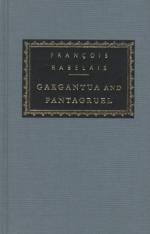A eulogistic quatrain is signed Nature quite, which, it is generally agreed, is an anagram of Jean Turquet. Did the adapter of the fifth book sign his work in this indirect fashion? He might be of the Genevese family to whom Louis Turquet and his son Theodore belonged, both well-known, and both strong Protestants. The obscurity relating to this matter is far from being cleared up, and perhaps never will be.
It fell to my lot—here, unfortunately, I am forced to speak of a personal matter—to print for the first time the manuscript of the fifth book. At first it was hoped it might be in Rabelais’ own hand; afterwards that it might be at least a copy of his unfinished work. The task was a difficult one, for the writing, extremely flowing and rapid, is execrable, and most difficult to decipher and to transcribe accurately. Besides, it often happens in the sixteenth and the end of the fifteenth century, that manuscripts are much less correct than the printed versions, even when they have not been copied by clumsy and ignorant hands. In this case, it is the writing of a clerk executed as quickly as possible. The farther it goes the more incorrect it becomes, as if the writer were in haste to finish.
What is really the origin of it? It has less the appearance of notes or fragments prepared by Rabelais than of a first attempt at revision. It is not an author’s rough draft; still less is it his manuscript. If I had not printed this enigmatical text with scrupulous and painful fidelity, I would do it now. It was necessary to do it so as to clear the way. But as the thing is done, and accessible to those who may be interested, and who wish to critically examine it, there is no further need of reprinting it. All the editions of Rabelais continue, and rightly, to reproduce the edition of 1564. It is not the real Rabelais, but however open to criticism it may be, it was under that form that the fifth book appeared in the sixteenth century, under that form it was accepted. Consequently it is convenient and even necessary to follow and keep to the original edition.




